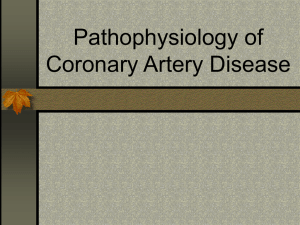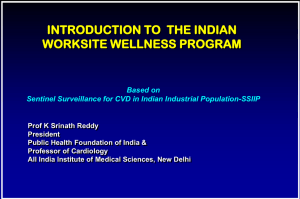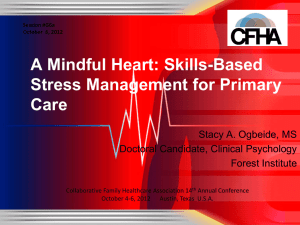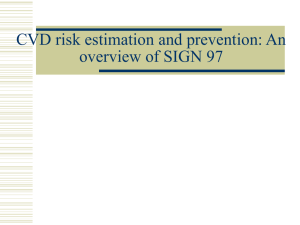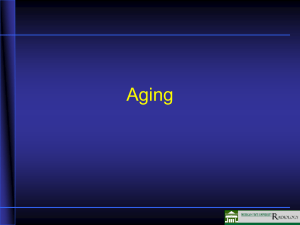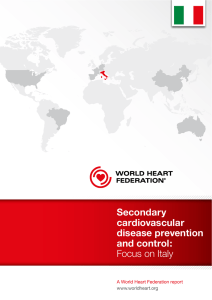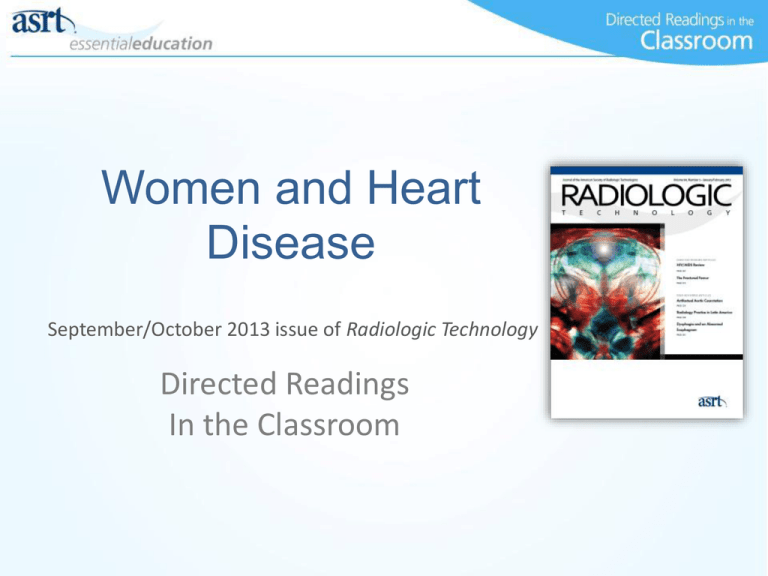
Women and Heart
Disease
September/October 2013 issue of Radiologic Technology
Directed Readings
In the Classroom
Instructions:
This presentation provides a framework for educators
and students to use Directed Reading content
published in Radiologic Technology. This information
should be modified to:
1.
Meet the educational level of the audience.
2.
Highlight the points in an instructor’s discussion or presentation.
The images are provided to enhance the learning
experience and should not be reproduced for other
purposes.
Introduction
Heart disease is known more as a killer of men than women, but U.S.
women have surpassed men in prevalence of and mortality from
cardiovascular diseases. Although recent years have witnessed an
upswing in education, awareness, and clinical research focused on
heart disease in women, much work remains to reach a sufficient
understanding of the differences in risk, presentation, and
management of heart disease between the sexes to improve
outcomes for women. Medical imaging has enhanced diagnosis and
management of heart disease in women, especially by enabling less
invasive approaches.
Introduction
Most women believe that breast cancer is the greatest threat to their
health, but cardiovascular disease (CVD) has killed more women in
the United States nearly every year since 1900 than any other
disease. In 2007, reports estimated that approximately 1 woman died
every minute in the United States from CVD. The total represents
more deaths than from the combined causes of cancer, chronic lower
respiratory disease, Alzheimer disease, and accidents.
With increasing awareness, education, and management, women’s
mortality from CVD in the United States declined from 2000 to 2007.
There still is much to learn, however, about differences in the
presentation of heart disease in women and much to gain toward
closing the gaps in disparities in disease management and research.
Pathophysiology and Disease
Presentation
Pathophysiological differences exist between the sexes in clinical
presentation of disease, diagnostic procedures, and how men and
women respond to treatment. Important factors such as vascular and
myocardial physiology, structure, and function are examples. What’s
more, men and women differ at the most basic cellular levels and
even in responses or reactions to medications. Many of the
differences between vasculature of men and women can be
attributed to female sex hormones.
Clinicians point to several cardiovascular abnormalities that appear to
be more common in women, including vasospastic disorders,
Raynaud phenomenon, migraine headaches, and some forms of
vasculitis. Women’s vasculature is smaller and stiffer than men’s,
which can impair coronary reserve flow.
Pathophysiology and Disease
Presentation
Researchers also have studied at length the sex differences in
pharmacokinetics. Women tend to have higher incidence of adverse
drug reactions, and there have been reports of the complex effect of
a patient’s sex on how drugs metabolize in the liver and
gastrointestinal tract. There likely are sex differences in how women
and men excrete medications and absorb topical medications through
the skin.
Cardiovascular Diseases:
Atherosclerosis
Sex differences also play a role in the pathophysiology and disease
presentation of many forms of cardiovascular disease.
The buildup and hardening of plaque in the arteries’ inner walls leads
to coronary artery disease and eventually can cause acute coronary
syndrome (heart attacks and unstable angina). Plaque rupture (a
lesion rich in lipids with a necrotic core and a thin, ruptured fibrotic
cap) is more common in men, but plaque erosion, which is an acute
thrombus directly on the vessel’s intima, is more common in women.
Once a woman reaches menopause, the incidence of plaque rupture
increases.
Hypertension
High blood pressure is a significant risk factor for CAD, along with
coronary heart failure, stroke, and other heart diseases or conditions
that lead to heart disease. Most notably, hypertension is a defining
condition of the metabolic syndrome, the group of conditions that
puts people at risk for heart disease and diabetes.
Genetics also play a role in hypertension risk, and sex differences are
apparent until women reach menopause. By the time they reach
menopause, women no longer have an advantage over men in
hypertension incidence, and the most likely reason is a decrease in
the protective effects of female sex hormones as a result of
menopause.
Coronary Artery Disease
In general, the chest pain, pressure, and squeezing that represent
angina pectoris are symptomatic of myocardial ischemia. Angina is
the most common major presentation of coronary heart disease
among women.
Some reports have stated that the metabolic syndrome is associated
with CAD in women more than obesity. Women who have acute
coronary syndrome typically have elevated C-reactive protein and
brain natriuretic peptide, but men have different elevated
biomarkers. Women tend to have more small vessel disease, vascular
inflammation, and congestive heart failure, but men experience more
plaque rupture, platelet-rich thrombi, and microembolization.
Peripheral Artery Disease
Men have a higher risk of peripheral artery disease than women, and
only about 10% of patients of both sexes complain of pain from
claudication.
Up to 66% of elderly women with the condition are completely
aymptomatic.
Hypertension is an important risk factor for peripheral artery disease,
and women have a higher age-adjusted risk than men.
Myocardial Infarction
Recent studies have confirmed 9 risk factors that account for more
than 90% of myocardial infarctions (MI) in both sexes and 94% of
those that occur in women. The risk factors are cigarette smoking,
hypertension, diabetes, abdominal obesity, psychosocial factors, poor
fruit and vegetable intake, lack of exercise, alcohol intake, and
apolipoprotein B/apolipoprotein A-I ratio.
The strength of these risk factors’ associations with heart attack risk is
nearly equal among men and women, with the exception of diabetes,
which has a much stronger association for women.
Women are more likely to have a recurrent MI and be disabled by
heart failure after the recurrent heart attack.
Heart Failure
When the heart cannot meet the body’s requirements for normal
filling pressures, it is known as congestive heart failure. At 40 years
old, women have a higher lifetime risk of developing heart failure
than men do.
The combined effects of hypertension, steeper relationship of blood
pressure to blood volume, and more diastolic dysfunction likely
explain why women tend to have congestive heart failure more often
than men do despite the fact that women have better left ventricular
function.
Arrhythmia
The effects of sex hormone receptors on the heart’s electrophysiology
differ between men and women, causing decreased QTc intervals in
men after puberty but increased QTc intervals in women only after
menopause.
Women also have shorter atrial refractoriness, particularly after
menopause. Women have a slightly higher incidence of atrial
fibrillation than men, along with a tendency toward more strokes
related to atrial fibrillation.
Cerebrovascular Disease
The lifetime risk of dying from a stroke is almost double for women
compared with men. Women account for slightly more than 60% of all
stroke deaths in the United States. Risk factors for cerebrovascular
disease are similar to those for cardiovascular disease, such as
smoking, diabetes, hypertension, and inactivity. Use of hormone
replacement therapy also increases stroke risk in women.
Women older than aged 60 years, those with diabetes, or those who
have symptoms lasting more than 10 minutes during a transient
ischemic attack are more likely to have a stroke following a transient
ischemic attack.
Spontaneous Coronary Artery
Dissection
Spontaneous coronary artery dissection (SCAD) is an infrequent cause
of acute coronary syndrome with uncertain origin and clinical
features. A hematoma or dissection in the coronary intima or media
are hallmark findings. SCAD typically affects younger otherwise
healthy people, particularly women in peripartum or postpartum
states. In men, SCAD appears most often following extreme physical
activity.
In more than half of cases, SCAD is life-threatening, and diagnosis is
complicated by a bias regarding chest pain in young patients,
particularly young women.
Heart Disease Risk
Not all coronary events that occur in women can be explained by
traditional CVD risk factors, and many of the tools designed to assess
risk for MI are less effective at predicting MI risk in women. Risk
factors for many cardiovascular diseases are categorized as modifiable
or unmodifiable. For example, people cannot alter their age or family
history. Other risk factors are potentially modifiable.
Even sex-specific differences in first-degree relatives who have had
cardiovascular diseases differ depending on the sex of the relative
and the patient.
Nonmodifiable Risk Factors
Age is likely the most powerful risk factor for heart disease, especially
for women. Men have a higher risk for heart disease through age 59
years, but at age 60 years, risk equalizes between the sexes and then
becomes higher for women as they age than it is for men.
Having a family history of MI or stroke significantly affects risk of the
diseases for men and women. Family history is a complex factor that
likely expresses differently in men and women but is still being
investigated.
Migraines have been shown to have a complex relationship with
cardiovascular disorders. Migraines have been identified as a risk
factor for ischemic stroke and CAD, yet certain cardiac anomalies have
been investigated as causes of migraines as well.
Modifiable Risk Factors
Lifestyle factors that increase risk are modifiable.
A large review demonstrated that the risk for women who smoke is
25% higher than for men who smoke. Plaque erosion is associated
with smoking, especially in women who smoke. Smoking is positively
correlated with sudden coronary death.
Stroke risk from migraines presents an excellent example of how
nonmodifiable and modifiable risk factors interact: Although young
women with migraines are at increased risk, those who smoke or use
oral contraceptives and also have migraines are at much higher risk
for stroke.
Being overweight or obese increases risk for metabolic syndrome,
diabetes, and CVD.
Potentially Modifiable Risk Factors
Although Type 1 diabetes is nonmodifiable, the more common Type 2
diabetes can be attributed to both modifiable and nonmodifiable
causes. Age, family history, and race or ethnic background are among
nonmodifiable risk factors for diabetes. Being overweight or obese,
remaining physically inactive, having hypertension, and smoking are
among modifiable factors. Diabetes is such a significant risk factor for
cardiovascular disease that it is considered a “cardiovascular disease
equivalent.”
Hypertension is potentially modifiable, partly because of factors such
as salt intake that can affect blood pressure. Blood pressure also can
be treated with behavior modification and medication, but women as
a population are undertreated.
Psychosocial Risk Factors
Women with angina tended to have higher anxiety levels. In fact,
depression is a risk factor for cardiac events along with being an
outcome of major cardiac events.
Many people who have chronic diseases experience depression,
anxiety, stress, and other psychosocial issues that can make it more
difficult to manage their diseases. Some research has suggested that
women might experience more psychosocial problems after an acute
cardiac event than men do.
Disparities in Care
The term “health disparities” generally refers to differences in
indicators of health among population groups. Often, it is applied to
certain races or cultures or people living in a particular geographic
area or within a socioeconomic group.
Although progress has been made in the understanding of women’s
heart disease, a gap remains in awareness of how risk, disease
presentation, and mortality differ between men and women. This gap
is particularly apparent among women and physicians, yet awareness
is important to preventing and treating CVD. Disparities also continue
to some extent in the representation of women in clinical research
trials and in the management of CVD among female patients.
Awareness
In 1997, an American Heart Association survey found that only 7% of
women reported CVD as the disease with the most health and
mortality risk. The American Heart Association developed several
efforts such as the Go Red for Women campaign aimed at improving
women’s awareness of CVD risks. Nevertheless, a 2009 survey of
women reported that only about half correctly identified CVD as the
leading cause of death among women; only 1 in 6 surveyed correctly
identified CVD as women’s leading health risk.
In addition, there is a fundamental lack of understanding among
health care providers about the mechanisms of early-stage CVD and
symptoms in women.
Clinical Trial Representation
As recently as the 1990s, relatively few clinical studies were available
to assist clinicians in treating women with CVD. Clinicians often have
had to rely on evidence from trials that mostly or entirely enroll men.
The improvement in survival rates for women with CVD from 2000 to
2007 could be partly attributed to heightened application of
evidence-based therapies and preventive interventions targeted at
women. In 2007, a meeting involving representatives from academia,
regulatory agencies, and industry was held to develop strategies for
improving representation of women in CVD clinical trials and to
ensure that clinical trial results are reported by sex.
Treatment Disparities
Although awareness has improved somewhat, significant disparity
remains between the sexes in terms of CVD treatment, and more
progress has been made overall in decreasing the number of deaths
from heart disease among men than among women. Women are less
likely to receive the appropriate treatment for CVD and are more
likely to die from open heart surgery or within 1 year of having an MI.
A lack of awareness and clinical inertia could contribute to physicians
failing to adhere to practice guidelines regarding cardiac care for
women. Primary care physicians often do not have cardiac risk
prevention services integrated into their routine care.
Treatment Disparities
CAD presentation differs significantly between men and women,
often leading to delayed diagnoses and treatment.
Women’s perceived risk for heart disease vs actual risk causes many
of the differences between the sexes in the use of appropriate
preventive measures for CVD. Because women wait longer before
seeking treatment for CVD, they are more likely to have poorer
outcomes than men.
Improving physician awareness and education can help offset
women’s lack of risk appreciation, but women still need to
understand risk and symptoms.
Barriers in Care
Both men and women can face socioeconomic barriers to care, but
some are specific to women.
For example, women often have trouble adhering to heart disease
prevention guidelines because of family caregiving responsibilities,
stress, sleep deprivation, fatigue, and a general lack of personal time.
In addition, some psychosocial factors specific to women interfere
with adherence to medical recommendations, particularly regarding
lifestyle modifications. Women who have low incomes or significant
social disadvantages are at higher risk for depression and anxiety,
which can exacerbate heart disease.
Diagnosing Heart Disease in
Women
Education for women and physicians regarding awareness of women’s
heart disease should include information about recognizing
symptoms of CVD, and particularly MI, that are unique to women.
Both sexes tend to experience chest pain as the most common
symptom.
Women also experience more subtle symptoms such as
lightheadedness, a squeezing sensation in their backs, or shortness of
breath even when at rest. They also might break out in a cold sweat.
Women are more likely to have gastrointestinal symptoms, sweating,
fatigue, and arm or shoulder pain in the absence of chest pain.
Diagnostic Strategies
Diagnostic work-up varies depending on the patient’s symptoms and
suspected disease but should include a thorough medical history to
identify potential heart disease symptoms and comprehensively
assess CVD risk factors. The medical history should include questions
regarding family history of heart disease and known risk factors for
CVD.
Cardiac biomarkers also can be ascertained to help determine
whether a patient is in need of emergency care when presenting with
chest pain.
Research is lacking as to the most effective strategy to rule out a CAD
diagnosis in women.
Diagnostic Strategies
Exercise electrocardiogram (ECG) stress testing often is used to first
investigate women with cardiac symptoms such as stable angina, but
stress testing recommendations usually are based on studies
performed primarily on men.
Exercise testing works well as a first test in diagnosing stable angina in
women, but coronary angiography also should be part of the initial
investigation. The Duke Treadmill Score is commonly used in the
United States and appears to work equally well for both sexes.
Alternatives to exercise stress tests are stress nuclear imaging, stress
echocardiography, computed tomography (CT) angiography/electron
beam CT, and magnetic resonance (MR) imaging. Many imaging
modalities also are used to confirm diagnoses or exclude CVD.
Imaging
Advances in cardiac imaging techniques have improved diagnosis of
heart disease in men and women. Imaging modalities such as
myocardial perfusion imaging (MPI), echocardiography, CT, MR, and
angiography have enhanced diagnosis and management and enabled
less invasive approaches.
Several imaging methods have been suggested to help better classify
heart disease risk in women but have not been sufficiently studied or
shown to significantly improve outcomes. Among these are coronary
calcium scoring and carotid ultrasound.
Although risk factors for CVD specific to women have been identified,
researchers have yet to determine how useful screening for these risk
factors can be in improving outcomes for female patients.
Imaging Modalities: Chest
Radiography
Chest radiography usually follows an immediate electrocardiogram
(ECG) for patients who come to emergency departments with
suspected unstable angina. The chest radiograph can help physicians
exclude other causes of chest pain, particularly in patients who have
acute but nonspecific chest pain and low probability of CAD.
A chest radiograph also is helpful in evaluating valvular heart disease
by showing calcified valves, pulmonary venous congestion, or changes
in ascending aortic root size.
SPECT MPI
SPECT is a nuclear imaging method that uses radionuclides such as
Thallium-chloride and Technetium-labeled agents.
SPECT MPI or other perfusion imaging generally is recommended for
women who report angina symptoms but who have normal resting
ECG results.
Gated SPECT can assess and calculate left ventricular function, which
is critical to determining the cause of defects in ventricular function.
The modality also can assess myocardial viability, which can be useful
to physicians when assessing patients for coronary artery bypass
grafting.
CCTA
Although contrast-enhanced coronary CT angiography (CCTA) can be a
reasonable alternative for some patients, the risk of cancer from the
examination’s radiation is higher for women, particularly younger
women. Breast cancer is of particular concern from CCTA.
One of the concerns regarding use of CCTA before coronary
catheterization is that should intervention be required, the patient
has to undergo 2 procedures, negating CCTA’s usefulness. A recent
study involving 15 000 patients from the Coronary CT Angiography
Evaluation for Clinical Outcomes (CONFIRM) database demonstrated
that few of those who had mild or moderate CAD required invasive
procedures. They found that using CCTA as a gatekeeper examination
would be less expensive and is less invasive.
Echocardiography
Stress echocardiography is effective and safe in women. It is
equivalent to SPECT MPI in the emergency setting for patients with
low to intermediate risk of an acute coronary event.
Transesophageal and transthoracic echocardiography frequently help
define ventricular wall motion abnormalities. The examinations may
be conducted with or without pharmacologic stress.
Tissue Doppler imaging has made echocardiography more useful for
detecting subclinical heart failure. Research has shown that reference
values for annual velocities should be specified by age and sex.
Ultrasonography
Intravascular ultrasound can show plaque in coronary arteries that is
determined as “normal” on angiograms.
Arterial duplex Doppler sonography can provide real-time images to
localize atherosclerotic disease.
Ultrasonography also can help assess stent or graft patency after
revascularization, which can be particularly helpful in women, who
often have complications following endovascular repair.
MR Imaging
MR is limited in its usefulness for cardiac imaging in the emergency
setting because of equipment availability.
Delayed postcontrast and edema-weighted imaging can help
definitively assess the extent, size, and distribution of MI.
MR imaging also can help identify aortic dissection and other
noncardiac findings of chest pain.
In nonemergency settings, MR angiography (MRA) may use contrast
or noncontrast protocols to identify vascular pathology. MRA may be
used to evaluate, assess the severity of, or follow up on vascular
system diseases. MRA is a useful alternative for women who have
contraindications to CCTA or to more invasive coronary angiography.
Coronary Angiography
Cardiac catheterization with coronary digital subtraction angiography
is the most proven method to date at demonstrating CAD and
allowing for immediate therapeutic intervention.
During catheterization, the images can demonstrate narrowing of the
vessel lumen, along with the number of diseased vessels.
Coronary angiography is invasive, however, and is rarely indicated
when patients have a low risk or probability of CAD. Less invasive
CCTA and MRA methods have essentially replaced diagnostic
angiography.
Emergency Imaging
ACR appropriateness criteria suggest SPECT MPI at rest and under
stress and coronary arteriography as the highest-rated imaging
methods for acute pain suggestive of coronary syndrome.
Unstable angina, ST-segment elevation MI (STEMI), or non-STEMI
could be indicated by acute chest pain, and a rapid, accurate
diagnosis is critical. Once the ECG and cardiac biomarkers suggest
acute coronary syndrome, the patient should have percutaneous
intervention within 90 minutes of arriving at the hospital, and if there
are changes to the ECG or clinical symptoms, the patient might be
immediately transferred to the cardiac catheterization laboratory.
Patients who are stable and do not have ST elevation can receive a
more conservative imaging approach.
Special Considerations for
Technologists
Radiation safety is of concern for all radiologic technologists when
conducting medical diagnostic imaging that uses ionizing radiation on
any patient. In particular, CCTA and cardiac catheterization
procedures can involve high levels of radiation.
Technologists and other radiology personnel who provide diagnostic
medical imaging services and care to women with suspected heart
disease need to consider certain factors with regard to radiation,
pregnancy, and other biological factors.
Radiation Effects in Women
Deterministic effects from radiation are those that occur when a
certain tissue receives absorbed dose above a specific threshold.
Examples of deterministic effects are skin erythema and epilation.
Stochastic effects are more long term in nature and can eventually
result in malignancy.
Radiology professionals, particularly those who work in
catheterization labs and with CCTA, must consider radiation effects
and potential pregnancy in any female patient of childbearing age,
along with characteristics of radiation effects in women.
Pregnancy
Heart disease is the leading cause of death during pregnancy other
than obstetric-related causes. Several cardiovascular changes take
place in a pregnant woman’s body, including increased cardiac output
and peripheral vascular resistance.
Radiation injury to the fetus is a risk among pregnant patients.
Ordering physicians and radiologists must work with pregnant women
to balance the need for certain information that can be obtained from
diagnostic medical imaging methods that use ionizing radiation with
potential risks.
Breast Tissue
CCTA usually includes most of a woman’s breast tissue within the
examination scan range.
One group of researchers investigated a method for displacing the
breasts outside of the scan range and shielding the breast surface to
determine effects of the technique on image quality and dose. The
authors divided a group of women undergoing CCTA into 3 subgroups.
One group received breast displacement, the second received
displacement and breast shielding, and the third was a control group.
Those who had displacement and shielding showed a 36% dose
reduction, and no significant difference in image quality was detected
among groups, although glandular breast tissue was largely removed
from the scan range.
Devices and Medications
Women who undergo endovascular repair of abdominal aortic
aneurysms fare better than those who have open surgical procedures
to repair their aneurysms but still have higher complication rates and
mortality than men who have the procedures. One explanation could
be that women usually have smaller femoral and iliac arteries, which
complicates or makes impossible the passage of endovascular
devices.
Although some advances have improved outcomes for women
undergoing percutaneous coronary interventions, others likely added
to complications in women. Interventional devices such as
rotablation, directional coronary atherectomy, and laser therapy
appeared to add to complications in female patients more than in
male patients.
Devices and Medications
Women’s different physiologic makeup influences device
effectiveness and can cause differences in reactions to or
effectiveness of medications. For example, women tend to have lower
serum potassium levels than men.
Age and sex have been found to affect contrast-induced acute renal
injury. Because women are smaller, typically older when having CVD
interventions, and are more likely to have renal impairment than
men, they are more inclined to receive excess doses of anticoagulant
therapies, resulting in bleeding problems, and they also might receive
excessive doses of contrast agents, which could result in contrastinduced nephropathy.
Bleeding Complications
Even with improvement in technique and regimens to control
bleeding during percutaneous coronary interventions, women
continue to have more bleeding complications than men. Most
bleeding and vascular complications probably are caused by women’s
smaller and stiffer vasculature.
As a rule, women being evaluated for acute coronary events often are
older than men and have more comorbidities that could lead to
complications or death from invasive procedures. Hypertension,
hyperlipidemia, diabetes, and heart failure are among common
comorbidities. Providers should discuss the risks, benefits, and
alternatives with patients when bleeding or thromboembolism are
concerns for cardiac imaging and therapeutic procedures.
Quality of Life
In a 2008 report on women’s health research, the IOM stated that
although there has been progress toward reducing mortality from
CVD in women, researchers needed to focus more on quality-of-life
issues for women with heart disease. For example, enhancing
wellness to prevent disease, improving functionality and mobility, and
addressing disparities in care and disease burden could improve
women’s health and lives.
Up to 25% of women with angina pectoris have reported symptoms
of clinical depression before reporting for cardiac rehabilitation, and
depression is more common in general among women with heart
disease.
Quality of Life
When gender differences are addressed, women consistently appear
to have higher anxiety and stress. Norris et al suggested use of the
Hospital Anxiety and Depression Scale as a screening instrument to
accurately measure anxiety in women with CAD, along with
depression among men with the disease.
Sleep disturbances and adverse effects from medication can cause a
great deal of anxiety for women, as can fear regarding their disease.
Further research also can help explain the complex relationships of
such socioeconomic factors as income, race or ethnicity, and sex on
quality of life for women with heart disease.
Prevention
The goal of primary CVD prevention is to help women avoid
developing heart diseases by promoting healthy habits. Changing
behaviors such as salt intake and tobacco use and improving physical
exercise and fitness are excellent steps toward CVD prevention.
Secondary prevention includes the identification and treatment of
women with established heart disease or those at very high risk and
the rehabilitation of women who have already had a heart attack to
prevent a second attack. The incidence of young women who have
MIs might be low, but mortality is very high among young women
with family history of heart attack who have an MI. This is an area in
need of improved primary prevention.
Prevention
Pharmacologic interventions also may be used to help prevent CVD in
women depending on their risk level and contraindications. These
may include the use of beta-blockers, warfarin, statins to lower
cholesterol, or the use of aspirin. Aspirin use to prevent incidence or
death from MI in women still generally is recommended only for
women at highest risk. Aspirin had more effect in reducing risk of
nonfatal MI in women older than 65 years but increased incidence of
severe gastrointestinal bleeding.
Women are less likely to be discharged from the hospital with a
prescription to take aspirin following an acute coronary event than
men are.
Conclusion
Although it took several decades to include women in research about
CVD, the results of the work are increasing attention to sex
differences in cardiovascular disease prevention, diagnosis, and
management. Further investigation is needed to continue to establish
the differences between risk of heart disease for men and women
and to eliminate disparities in prevention, care, and outcomes.
Keeping sex and gender role differences in mind when caring for
women at risk for heart disease or who have heart disease can
improve quality of life and outcomes for female patients.
Continued emphasis on sex-specific clinical research and improved
application of the knowledge gained in clinical practice offers a
promising future for women at risk for heart disease.
Discussion Questions
Explain problems with awareness of heart disease risk
in women.
List modifiable, nonmodifiable, and potentially
modifiable risk factors for heart disease in women.
Discuss the role of medical imaging in diagnosing heart
disease in women.
Additional Resources
Visit www.asrt.org/students to find information
and resources that will be valuable in your
radiologic technology education.



